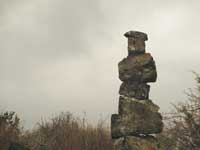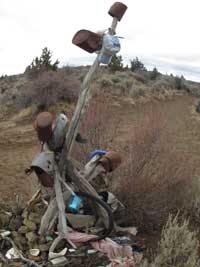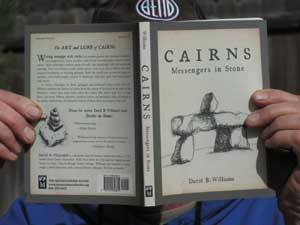 In his latest book, Cairns: Messengers in Stone (The Mountaineers Books), David B. Williams explores the concept and meaning behind cairns – those trailside piles of rocks. Much more than just random mounds of stone, cairns have served as property markers, claim boundaries, trail indicators and trailside shrines for hundreds, if not thousands of years. From the dropping of bread crumbs by Hansel and Gretel, to trailside shrines and Bronze Age burials, Williams stacks up stony evidence for the construction of cairns across the ages.
In his latest book, Cairns: Messengers in Stone (The Mountaineers Books), David B. Williams explores the concept and meaning behind cairns – those trailside piles of rocks. Much more than just random mounds of stone, cairns have served as property markers, claim boundaries, trail indicators and trailside shrines for hundreds, if not thousands of years. From the dropping of bread crumbs by Hansel and Gretel, to trailside shrines and Bronze Age burials, Williams stacks up stony evidence for the construction of cairns across the ages.
Cairns have served as the “I was here” vocabulary of explorers, but as Williams describes, the stone piles had other intentions or meanings in various societies. In pre-Columbian Incan society, road builders put up cairns where monumental ascents and descents greeted the traveler. For others, a cairn’s individual stones held a traveler’s fear or fatigue; a rock tossed onto a cairn transferred the traveler’s conditions to the sanctity of the cairn.
 During the Golden Age of Exploration, cairns were sought by searchers for evidence of overdue exploration parties. A found cairn could lead to journal notes or artifacts of Western civilization such as musket balls, tin cans or coins. The statement of “We were here” might be the only clue searchers uncovered in determining the explorer’s fate. Plus, marking one’s passage through an unknown area offered the added benefit of showing the way home.
During the Golden Age of Exploration, cairns were sought by searchers for evidence of overdue exploration parties. A found cairn could lead to journal notes or artifacts of Western civilization such as musket balls, tin cans or coins. The statement of “We were here” might be the only clue searchers uncovered in determining the explorer’s fate. Plus, marking one’s passage through an unknown area offered the added benefit of showing the way home.
On a more local level, Williams and I both worked in Arches National Park, although in different years. In Cairns he talks about knocking over excess or “unofficial” cairns, a practice that I, too, spent many a day on. In the unmarked Fiery Furnace, these markers were erected by visitors to find their way out.
At Arches and throughout the Southwest, cairns serve well as trail markers to special locations. These rock stacks stand out well in the open landscape. Viewed from afar, the cairns provide a beacon for travel, a target for hikers to follow. Of course, not all the travelers were human; cairns offered lizards, birds and small mammals an elevated perch from which to better view their world.
 Throughout Canyon Country, not all cairns are constructed equally. I’ve seen stacks of cow patties or cairns made of rusty cans and old bones that marked some trails. Depending upon the location, the builders literally used the stone at hand, whether it was river cobble or petrified wood or slabs of sandstone. My favorites were those lone cairns constructed in some off-trail location, signatures that someone had been there before me. Of course, I kicked those ones over as well; their historic value worthless when compared to the wealth of rock art that adorns canyon walls.
Throughout Canyon Country, not all cairns are constructed equally. I’ve seen stacks of cow patties or cairns made of rusty cans and old bones that marked some trails. Depending upon the location, the builders literally used the stone at hand, whether it was river cobble or petrified wood or slabs of sandstone. My favorites were those lone cairns constructed in some off-trail location, signatures that someone had been there before me. Of course, I kicked those ones over as well; their historic value worthless when compared to the wealth of rock art that adorns canyon walls.
In Cairns, Williams gives life to trailside piles of stones. Whether they mark some high altitude pass in the Himalayas, a 19th century explorer’s last contact, or a shrine dedicated to loved ones, these silent stone messengers make a human connection across time and space. So check out this highly recommended read; you’ll never look at another cairn in quite the same way.